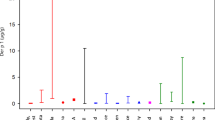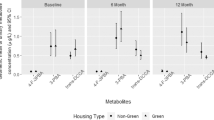Abstract
In this study, we investigated the 2,4-dichlorophenoxyacetic acid (2,4-D) herbicide exposures of 135 preschool-aged children and their adult caregivers at 135 homes in North Carolina (NC) and Ohio (OH). Participants were randomly recruited from six NC and six OH counties. Monitoring was performed over a 48-h period at the participants’ homes. Environmental samples included soil, outdoor air, indoor air, and carpet dust. Personal samples collected by the adult caregivers concerning themselves and their children consisted of solid food, liquid food, hand wipe, and spot urine samples. All samples were analyzed for 2,4-D (free acid form) by gas chromatography/mass spectrometry. 2,4-D was detected in all types of environmental samples but most often in carpet dust samples, with detection frequencies of 83% and 98% in NC and OH, respectively. The median level of 2,4-D in the carpet dust samples was about three times higher in OH homes compared to NC homes (156 vs. 47.5 ng/g, P<0.0002). For personal samples, 2,4-D was more frequently detected in the hand wipe samples from OH participants (>48%) than from NC participants (<9%). Hand wipe levels at the 95th percentile were about five times higher for OH children (0.1 ng/cm2) and adults (0.03 ng/cm2) than for the NC children (0.02 ng/cm2) and adults (<0.005 ng/cm2). 2,4-D was detected in more than 85% of the child and adult urine samples in both states. The median urinary 2,4-D concentration was more than twice as high for OH children compared to NC children (1.2 vs. 0.5 ng/ml, P<0.0001); however, the median concentration was identical at 0.7 ng/ml for both NC and OH adults. The intraclass correlation coefficient of reliability for an individual's urinary 2,4-D measurements, estimated from the unadjusted (0.31–0.62) and specific gravity-adjusted (0.37–0.73) values, were somewhat low for each group in this study. The variability in urinary 2,4-D measurements over the 48-h period for both children and adults in NC and OH suggests that several spot samples were needed to adequately assess these participants’ exposures to 2,4-D in residential settings. Results from this study showed that children and their adult caregivers in NC and OH were likely exposed to 2,4-D through several pathways at their homes. In addition, our findings suggest that the OH children might have been exposed to higher levels of 2,4-D through the dermal and nondietary routes of exposure than the NC children and the NC and OH adults.
This is a preview of subscription content, access via your institution
Access options
Subscribe to this journal
Receive 6 print issues and online access
$259.00 per year
only $43.17 per issue
Buy this article
- Purchase on Springer Link
- Instant access to full article PDF
Prices may be subject to local taxes which are calculated during checkout

Similar content being viewed by others
References
Arbuckle T., and Ritter L. Phenoxyacetic acid herbicide exposure for women on Ontario farms. J Toxicol Environ Health A 2005: 68: 1359–1370.
Baker S., Barr D., Driskell W., Beeson M., and Needham L. Quantification of selected pesticide metabolites in human urine isotope dilution high-performance liquid chromatography/tandem mass spectrometry. J Expo Anal Environ Epidemiol 2000: 10: 789–798.
Barr D., Wilder L., Caudill S., Gonzalez A., Needham L., and Pirkle J. Urinary creatinine concentrations in the US population: implications for urinary biologic monitoring measurements. Environ Health Perspect 2005: 113 (2): 192–200.
Bearer C. How are children different from adults? Environ Health Perspect 1995: 103 (Suppl. 6): 7–12.
Boeniger M., Lowry L., and Rosenberg J. Interpretation of urine results used to assess chemical exposure with emphasis on creatinine adjustment: a review. Am Ind Hyg Assoc J 1993: 54 (10): 615–627.
Carrieri M., Trevisan A., and Bartolucci G.B. Adjustment to concentration-dilution of spot urine samples: correlation between specific gravity and creatinine. Int Arch Occup Environ Health 2001: 74 (1): 63–67.
CDC (Centers for Disease Control and Prevention). 2005. Third National Report on Human Exposure to Environmental Chemicals, http://www.cdc.gov/exposurereport/.
Chance G., and Harmsen E. Children are different: environmental contaminants and children's health. Can J Public Health 1998: 89 (Suppl. 1): S9–S13.
Chuang J., Van Emon J., Durnford J., and Thomas K. Development and evaluation of an enzyme-linked immunosorbent assay (ELISA) method for the measurement of 2,4-dichlorophenoxyacetic acid in human urine. Talanta 2005: 67: 658–666.
Colt J., Lubin J., Camann D., Davis S., Cerhan J., Severson R., et al. Comparison of pesticide levels in carpet dust and self-reported pest treatment practices in four US sites. J Expo Anal Environ Epidemiol 2004: 14: 74–83.
Curwin B., Hein M., Sanderson W., Barr D., Heederik D., Reynolds S., et al. Urinary and hand wipe pesticide levels among farmers and nonfarmers in Iowa. J Expo Anal Environ Epidemiol 2005: 15: 500–508.
Egeghy P., Quackenboss J., Catlin S., and Ryan P. Determinants of temporal variability in NHEXAS-Maryland environmental concentrations, exposures, and biomarkers. J Expo Anal Environ Epidemiol 2005: 15 (5): 388–397.
Fleiss J. The Design and Analysis of Clinical Experiments. John Wiley & Sons, New York, NY, 1985.
Food and Drug Administration (FDA). 2003. Pesticide Program, Residue Monitoring, http://vm.cfsan.fda.gov/~dms/pes99rep.html.
Garabrant D., and Philbert M. Review of 2,4-dichlorophenoxyacetic acid (2,4-D) epidemiology and toxicology. Crit Rev Toxicol 2002: 32 (4): 233–257.
Hornung R., and Reed L. Estimation of average concentration in the presence of nondetectable values. Appl Occup Environ Hyg 1990: 5 (1): 46–51.
IRIS, US Integrated Risk Information System. 2006: http://www.epa.gov/iris.
Kissel J., Curl C., Kedan G., Lu C., Griffith W., Barr D., et al. Comparison of organophosphorus pesticide metabolite levels in single and multiple daily urine samples collected from preschool children in Washington State. J Expo Anal Environ Epidemiol 2005: 15: 164–171.
Knopp D., and Glass S. Biological monitoring of 2,4-dichlorophenoxyacetic acid-exposed workers in agriculture and forestry. Int Arch Occup Environ Health 1991: 63: 329–333.
Kohli J., Khanna R., and Gupta B. Absorption and excretion of 2,4-dichlorophenoxyacetic acid in man. Xenobiotia 1974: 4 (2): 97–100.
Meeker J., Barr D., Ryan L., Herrick R., Bennett D., Bravo R., et al. Temporal variability of urinary levels of nonpersistent insecticides in adult men. J Expo Anal Environ Epidemiol 2005: 15: 271–281.
Miller L., and Stapleton F. Urinary volume in children with urolithiasis. J Urol 1989: 141: 918–920.
Miller R.C., Brindle E., Holman D.J., Shofer J., Klein N.A., Soules M.R., et al. Comparison of specific gravity and creatinine for normalizing urinary reproductive hormone concentrations. Clin Chem 2004: 50 (5): 924–932.
Morgan M., Sheldon L., Croghan C., Chuang J., Lordo R., Wilson N., et al. A pilot study of children's total exposure to persistent pesticides and other persistent organic pollutants (CTEPP), 2004 EPA/600/R-041/193 http://www.epa.gov/heasd/ctepp/index.htm.
Nishioka M., Lewis R., Brinkman M., Burkerholder H., Hines C., and Menkedick J. Distributions of 2,4-D in air and on surfaces inside residences after lawn applications: comparing exposure estimates from various media for young children. Environ Health Perspect 2001: 109: 1185–1191.
Ohio Agricultural Research and Development Center. Pesticide Use on Turfgrass in Ohio 2001 Special Circular 191, August 2003 http://ohioline.osu.edu/sc191/index.html.
O’Rourke M., Lizardi P., Rogan S., Freeman N., Aguirre A., and Saint C. Pesticide exposure and creatinine variation among young children. J Expo Anal Environ Epidemiol 2000: 10: 672–681.
Pang Y., MacIntosh D., Camann D., and Ryan P. Analysis of aggregate exposure to chlorpyrifos int he NHEXAS-Maryland investigation. Environ Health Perspect 2002: 110 (3): 235–240.
Salita M., Macknin M., Medendorp S.V., and Jahnke D. First-morning urine specific gravity and enuresis in preschool children. Clin Pediatr (Phila) 1998: 37 (12): 719–724.
Sauerhoff M., Braun W., Blau G., and Gehring P. The fate of 2,4-dichlorophenoxyacetic acid (2,4-D) following oral administration in man. Toxicology 1977: 8: 3–11.
Scher D., Alexander B., Adgate J., Eberly L., Mandel J., Acquavella J., et al. Agreement of pesticide biomarkers between morning void and 24-h urine samples from farmers and their children. J Expo Sci Environ Epidemiol 2006: 17 (4): 350–357.
Szabo L., and Fegyverneki S. Maximum and average urine flow rates in normal children. Br J Urol 1995: 76: 116–120.
USEPA. 2004. Overview of the 2,4-D Risk Assessments, http://www.24d.org/govtrev/EPA-OPP-2004-0167-0002-Overview.pdf.
USEPA. 2005. 2,4-D Preliminary Risk Assessments-Questions and Answers, http://www.epa.gov/oppsrrd1/reregistration/24d/2_4d_ques_and_anws.htm.
Wilson N., Chuang J., Iachan R., Lyu C., Gordon S., Morgan M., et al. Design and sampling methodology for a large study of preschool children's aggregate exposures to persistent organic pollutants in their everyday environments. J Expo Anal Environ Epidemiol 2004: 14: 260–274.
Wilson N., Chuang J., Lyu C., Menton R., and Morgan M. Aggregate exposures of nine preschool children to persistent organic pollutants at day care and at home. J Expo Anal Environ Epidemiol 2003: 13 (1): 187–202.
Acknowledgements
We thank the children and their adult caregivers for participating in this important children's observational study. We would also like to thank Battelle staff members, particularly, C. Lyu, J. Satola, R. Lordo, Y. Chou, and S. Gordon, for their valuable contributions to the success of the CTEPP study.
Author information
Authors and Affiliations
Corresponding author
Rights and permissions
About this article
Cite this article
Morgan, M., Sheldon, L., Thomas, K. et al. Adult and children's exposure to 2,4-D from multiple sources and pathways. J Expo Sci Environ Epidemiol 18, 486–494 (2008). https://doi.org/10.1038/sj.jes.7500641
Received:
Accepted:
Published:
Issue Date:
DOI: https://doi.org/10.1038/sj.jes.7500641
Keywords
This article is cited by
-
Association between increasing agricultural use of 2,4-D and population biomarkers of exposure: findings from the National Health and Nutrition Examination Survey, 2001–2014
Environmental Health (2022)
-
Exposures to 2,4-Dichlorophenoxyacetic acid with or without endotoxin upregulate small cell lung cancer pathway
Journal of Occupational Medicine and Toxicology (2021)
-
Does soil track-in contribute to house dust concentrations of perfluoroalkyl acids (PFAAs) in areas affected by soil or water contamination?
Journal of Exposure Science & Environmental Epidemiology (2019)
-
Adult and child urinary 2,4-D in cities with and without cosmetic pesticide bylaws: a population-based cross-sectional pilot study
Journal of Exposure Science & Environmental Epidemiology (2017)
-
Urinary biomarkers of exposure to insecticides, herbicides, and one insect repellent among pregnant women in Puerto Rico
Environmental Health (2014)



